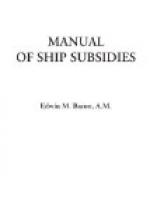The report of this Parliamentary committee is significant in the evidence it indirectly affords, confirming the declaration of 1853,[AT]—that the postal subsidies were not as assumed, payments solely for services rendered, but in fact were concealed bounties.
In 1871-72, when a renewed effort was made to establish an American line of American-built ships,[AU] the British subsidies were again increased. Then, also, was instituted by the Admiralty the naval subvention system—the payment of annual retainers to certain classes of merchant steamers, the largest and swiftest, in readiness for quick conversion into auxiliary naval ships in case of war, and to preclude their becoming available for the service of any power inimical to British interests.
At the expiration of the Cunard and Inman seven years’ contracts the postmaster-general applied the principle of payment according to weight throughout for the carriage of the North American mails. But preference was given to British ships, these receiving higher rates per pound than the foreign. In 1887 an arrangement was entered into by which the Cunard and Oceanic lines were to carry all mails except specially directed letters, and the pay was reduced.[AV] This method of payment continued till 1903.
Then another sharp change was made in the subsidy system to meet another, and most threatening American move. In 1902 was formed by certain American steamship men, through the assistance of J. Pierpont Morgan, the “International Mercantile Marine Company,” in popular parlance, the “Morgan Steamship Merger,” a “combine” of a large proportion of the transatlantic steam lines.[AW] Upon this, in response to a popular clamor, subsidy, and in a large dose, was openly granted to sustain British supremacy in overseas steam-shipping. To keep the Cunard Line out of the American merger, and hold it absolutely under British control and British capitalization, and, furthermore, to aid the company immediately to build ships capable of equalling if not surpassing the highest type of ocean liners that had to that time been produced (the highest type then being German-built steamers operating under the German flag), the Cunard Company were resubsidized with a special fixed subsidy of three-quarters of a million dollars a year, instead of the Admiralty subvention of about seventy-five thousand dollars, and in addition to their regular mail pay, the subsidy to run for a period of twenty years after the completion of the second of two high-grade, high-speed ocean “greyhounds” called for for the Atlantic trade. The Government were to lend the money for the construction of the two new ships at the rate of 2-3/4 per cent per annum, the company to repay the loan by annual payments extending over twenty years. The company on their part pledged themselves, until the expiry of the agreement, to remain a purely British undertaking, the management, the stock of the corporation, and their ships, to be in




